Groves classification system
The Groves Classification is a numbering system to enable the shape of any academic gown or hood to be easily described and identified. It was devised by Nicholas Groves to establish a common terminology for hoods and gowns to remedy the situation of individual universities using differing terms to describe the same item. As such it is used in same manner as an heraldic blazon whereby a textual description enables a coat of arms to be drawn. The system was first described in the Burgon Society's annual in 2001 and adopted as standard by robe makers and scholars of academic dress.
Classes
| Cape | Cowl | Liripipe | 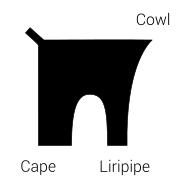 | |
| Full | ||||
| Simple | ||||
| Aberdeen |
The original Groves Classification included a standardization for shapes and patterns of hoods and gowns worn by graduates and undergraduates. Further information was given regarding the use of different fabrics and standardization of colours, but the focus was placed on gowns and hoods which are explained further below.
The Classification undergoes periodic revision as new hood and gown patterns emerge.
Hoods
Hoods in the Classification are divided into three different types as summarised in the table below. Unlike the gowns and robes, these are based on the shape of the hood rather than the degrees for which they are worn.
- [f] full shape hoods are those that have a cape, a cowl and a liripipe.
- [s] simple shape hoods have only a cowl and a liripipe.
- [a] Aberdeen shape hoods have only a cape and a vestigial cowl.
| Code number | Name | Pattern Rear view. Flat view | Notes |
|---|---|---|---|
| Full shape hoods | |||
| [f1] | Cambridge |  | Cape with square corners. |
| [f2] | Dublin | 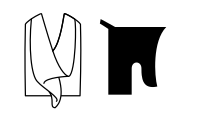 | As [f1] but the liripipe is curved at the inner corner. |
| [f3] | London |  | As [f1] but the cape corners are rounded. |
| [f4] | Durham Doctors |  | Used for doctoral degrees at the University of Durham. As [f7] but the liripipe is cut at a 45-degree angle and the cowl is slanted downwards. |
| [f5] | Oxford Full |  | Used for doctoral degrees at the University of Oxford. As [f7] but larger and with a narrow squared 'slot' between the liripipe edge and the cape. |
| [f6] | Durham BA | 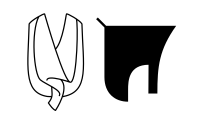 | Traditional shape for BA degrees at the University of Durham. As for [f7] but with a large, semi-circular cape, and the space between the cape and liripipe is cut in a quadrant arc. The liripipe is sewn on separately. |
| [f7] | Durham BSc | 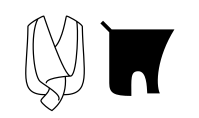 | As [f3] but the bottom of the cape has a rounded, semi-circular edge. |
| [f8] | Edinburgh Full |  | As [s4] but with a cape sewn on the back. |
| [f9] | Glasgow |  | Larger version of [f1], with a longer cape and a long narrow liripipe. Typically made with a wide neckband. |
| [f10] | St Andrews |  | Similar to [f3] but the liripipe is slightly slanted outward and has a slight bell-shape to the end. |
| [f11] | Warham Guild |  | Created to resemble the more ancient version of the hood. |
| [f12] | King's Full |  | Designed by Dame Vivienne Westwood in 2008 and features two long (4') streamers which serve as gown facings. There is no neckband, and the hood is held in place by a button fixed to the each shoulder of the gown. Owing to its unique shape the hood cannot be folded flat. For clergymen that require it, a version with a neckband is available. |
| [f13] | UMIST |  | |
| [f14] | ICC Doctors |  | |
| [f15] | Toronto |  | As [f14] but the liripipe is vertical rather than slanted. |
| Simple shape hoods | |||
| [s1] | Oxford Simple |  | |
| [s2] | Oxford Burgon |  | |
| [s3] | Belfast |  | |
| [s4] | Edinburgh |  | As for [f8] with the cape portion removed. |
| [s5] | Wales | 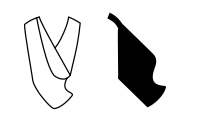 | |
| [s6] | Leicester Bachelors |  | |
| [s7] | Leeds |  | |
| [s8] | Sussex |  | |
| [s9] | Victoria |  | |
| [s10] | Aston |  | |
| [s11] | Glasgow Caledonian |  | Designed by Aileen Stewart in 1993 |
| [s12] | King's Simple | 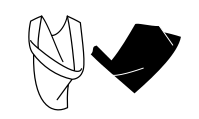 | |
| Aberdeen shaped hoods | |||
| [a1] | CNAA |  | |
| [a2] | Leicester Masters |  | |
| [a3] | Kent |  | |
| [a4] | East Anglia |  | |
| [a5] | Leicester Doctors |  | |
| [a6] | Dundee |  | |
| [a7] | Aberdeen |  | |
Gowns
Gowns in the Groves system are divided into three classes. These generally follow the shapes associated with each different academic degree in the British educational system.
- [b] bachelor's gowns typically have large open sleeves
- [m] master's gowns typically have long closed sleeves with armhole at elbow level
- [d] doctor's robes vary in shape widely between institutions and are all classed as [d].
Bachelors
Masters
| Sleeve pattern |  |  |  |  |  |  |  |  |  |
| Degree | Oxford MA | Cambridge MA | Dublin MA | Wales MA | London MA | Victoria MA | Lampeter BD | Leicester MA | Bristol MA |
| Code number | [m1] | [m2] | [m3] | [m4] | [m5] | [m6] | [m7] | [m8] | [m9] |
|---|---|---|---|---|---|---|---|---|---|
 |  |  |  |  |  |  |  |  | |
| Basic Master | Lancaster MA | Scottish MA | Not used | Open | Warwick MA | Bath MA | Sussex MA | Manchester MA | King's MA |
| [m10] | [m11] | [m12] | [m13] | [m14] | [m15] | [m16] | [m17] | [m18] | [m19] |
Doctors
Headwear
Additions
The Groves classification system was first published in 2001. Since that time, it has been adapted and changed to include newly devised academic dress and revisions of existing schemes. The Burgon Society maintains a comprehensive listing of system shapes on its website. In addition to those included above, the current list classifies undergraduate gowns in use throughout the United Kingdom and academic headwear.
American doctoral robes

In 2012, David Boven devised a system of classification to include unique doctoral robes in the United States of America. The Intercollegiate Code describes the form of dress for doctors at American institutions, but many have changed the colors of their robes. Several institutions have even developed unique forms of robes for the doctoral graduates. In all of these instances, there are some cases where
ICC Shape
Unique shapes
References
Further reading
- Nicholas Groves (ed.) (2011) Shaw's Academical Dress of Great Britain and Ireland; 3rd ed. Published by the Burgon Society,ISBN 978-0-95612723-5